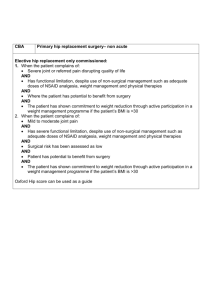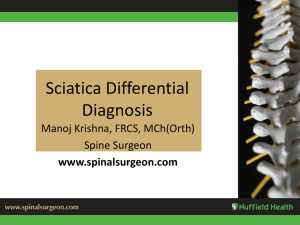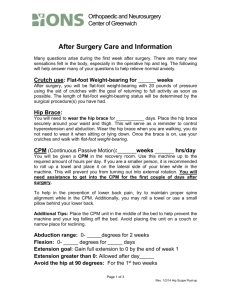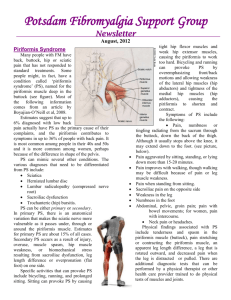PT protocol Arthroscopic Hip Therapist information LCMH
advertisement
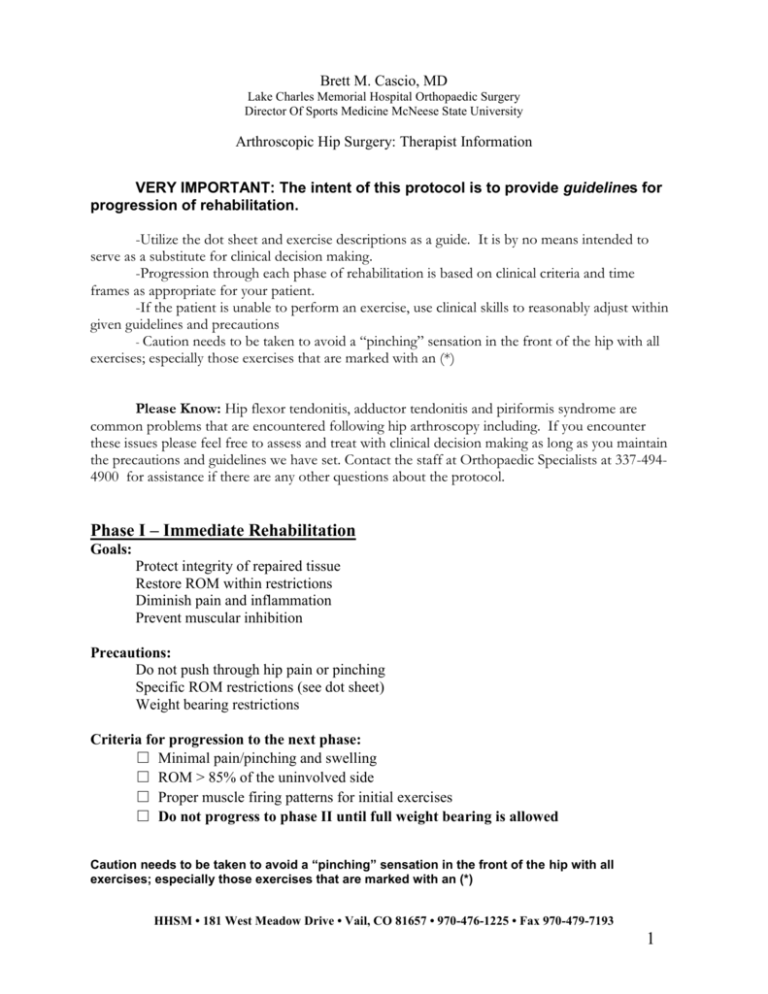
Brett M. Cascio, MD Lake Charles Memorial Hospital Orthopaedic Surgery Director Of Sports Medicine McNeese State University Arthroscopic Hip Surgery: Therapist Information VERY IMPORTANT: The intent of this protocol is to provide guidelines for progression of rehabilitation. -Utilize the dot sheet and exercise descriptions as a guide. It is by no means intended to serve as a substitute for clinical decision making. -Progression through each phase of rehabilitation is based on clinical criteria and time frames as appropriate for your patient. -If the patient is unable to perform an exercise, use clinical skills to reasonably adjust within given guidelines and precautions - Caution needs to be taken to avoid a “pinching” sensation in the front of the hip with all exercises; especially those exercises that are marked with an (*) Please Know: Hip flexor tendonitis, adductor tendonitis and piriformis syndrome are common problems that are encountered following hip arthroscopy including. If you encounter these issues please feel free to assess and treat with clinical decision making as long as you maintain the precautions and guidelines we have set. Contact the staff at Orthopaedic Specialists at 337-4944900 for assistance if there are any other questions about the protocol. Phase I – Immediate Rehabilitation Goals: Protect integrity of repaired tissue Restore ROM within restrictions Diminish pain and inflammation Prevent muscular inhibition Precautions: Do not push through hip pain or pinching Specific ROM restrictions (see dot sheet) Weight bearing restrictions Criteria for progression to the next phase: □ Minimal pain/pinching and swelling □ ROM > 85% of the uninvolved side □ Proper muscle firing patterns for initial exercises □ Do not progress to phase II until full weight bearing is allowed Caution needs to be taken to avoid a “pinching” sensation in the front of the hip with all exercises; especially those exercises that are marked with an (*) HHSM • 181 West Meadow Drive • Vail, CO 81657 • 970-476-1225 • Fax 970-479-7193 1 Phase II – Intermediate Goals: Protect integrity of repaired tissue Restore full ROM Restore normal gait pattern Progressively increase muscle strength Precautions: No ballistic or forced stretching NEVER use treadmill Avoid hip flexor, adductor, or piriformis inflammation Criteria for progression to the next phase: □ Full range of motion □ Pain free / normal gait pattern □ Hip flexion strength > 60% of the uninvolved side □ Hip add, abd, ext, IR, ER strength > 80% of the uninvolved side Phase III – Advanced Goals: Restoration of muscular endurance / strength Restoration of cardiovascular endurance Optimize neuromuscular control Precautions: Avoid hip flexor, adductor, and piriformis inflammation No ballistic or forced stretching / strengthening NEVER use treadmill No contact activities Criteria for progression to the next phase: □ Hip flexion strength > 70% □ Hip add, abd, ext, IR, ER strength > 90% of the uninvolved side □ Cardiovascular fitness equal to pre-injury level □ Demonstrates initial agility drills with proper body mechanics Phase IV – Sport Specific Training Criteria for full return to competition: □ Full pain free ROM □ Hip strength >85% of the involved side □ Ability to perform sport-specific drills at full speed without pain □ Completion of functional sports test HHSM • 181 West Meadow Drive • Vail, CO 81657 • 970-476-1225 • Fax 970-479-7193 2 Please follow the dot sheet for appropriate timelines and precautions. Use the information in this packet to determine if the patient is progressing appropriately. Post-operative Information Sutures: They are underneath the skin therefore will not need to be removed. CPM (continuous passive motion) machine: All patients will receive a CPM machine to use following surgery. This machine will move your patient’s leg through a pre-defined range of motion. The use of CPM has been shown to promote early healing following surgery. Most patients are required to use the CPM for 4 hours each day. If your patient has had a microfracture they will need to use the CPM for 8 hours each day for 8 weeks. Spending at least 2 hours daily lying prone will help prevent shortening of the hip flexor muscle following the CPM. Any questions of problems with the CPM machine Contact Ron Roberts at 281-772-8691 TED Stockings: TED Hose will be worn for Two weeks post op to try and prevent blood clots Rotational Boots: These are typically used for 10 days following surgery; 21 days following a capsule repair. Rotational boots are used to prevent external rotation when in a supine position and out of the CPM. Brace: The Bledsoe brace is to be worn for the first 10 days following surgery. The brace is worn only when ambulating. GameReady Cooling and Compression Machine: This is to be used as often as possible for the first two weeks to help control pain, swelling and inflammation. Should be worn continuously for the first 3 days post op and then a MINIMUM of 4-5 times a day for 30 minutes at a time for the remainder of the two weeks. Most patients sleep with it on every night till machine has to be returned. You cannot overuse this machine. If any questions or problems with the GameReady call Mike Roppolo 504-812-8001 HHSM • 181 West Meadow Drive • Vail, CO 81657 • 970-476-1225 • Fax 970-479-7193 3




